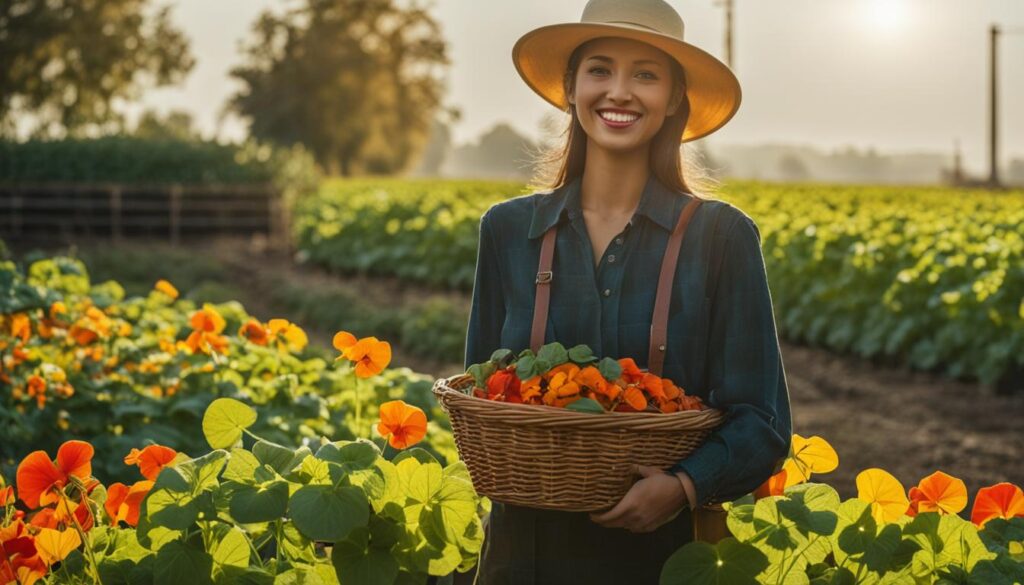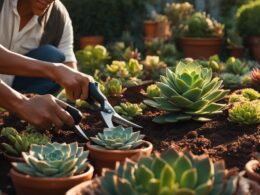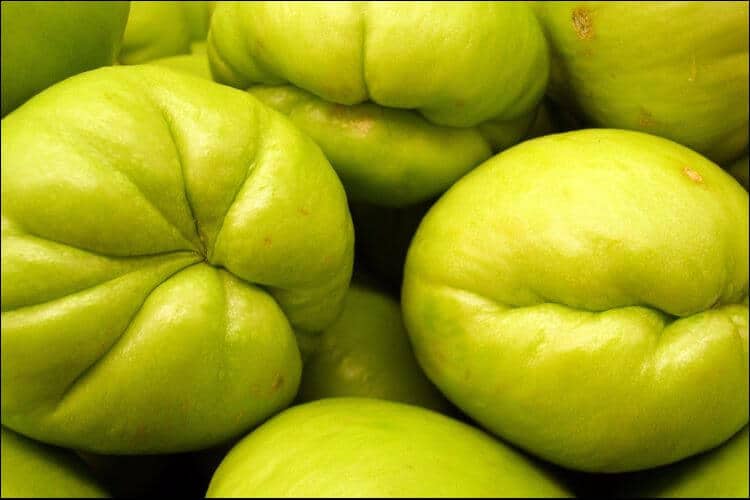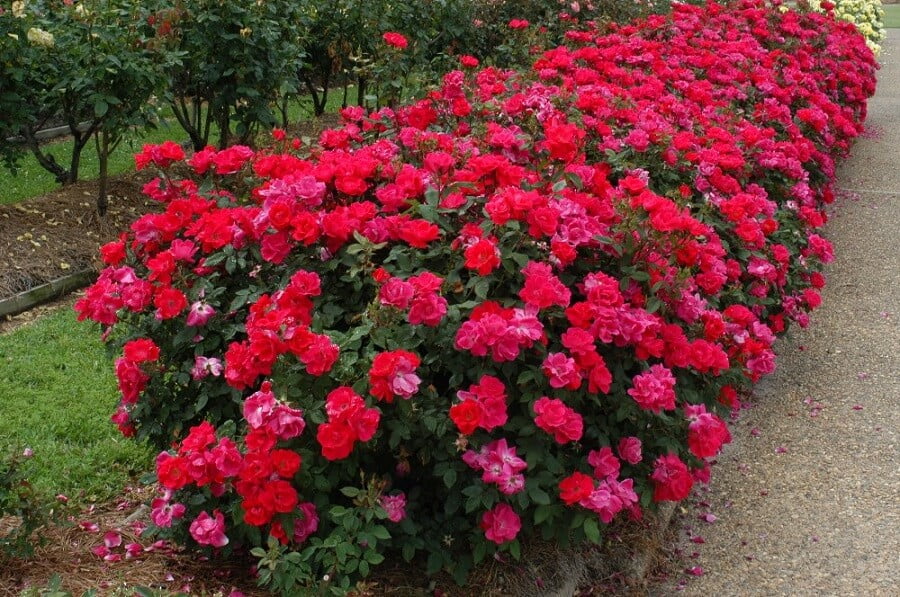Are you looking to enhance your gardening skills and create a harmonious garden? Companion planting is a fantastic technique that allows you to grow different plants together, maximizing their growth while naturally deterring pests. If you’re wondering how to grow nasturtiums and basil together, you’ve come to the right place! This dynamic duo not only complements each other in flavor and appearance but also brings a range of benefits to your garden.
Key Takeaways
- Companion planting combines different plants to optimize growth and deter pests naturally.
- Nasturtiums and basil are an excellent combination, both in terms of flavor and appearance.
- Grow nasturtiums and basil together to enhance the taste of your dishes and beautify your garden.
- Companion planting attracts beneficial insects, improves growth, and adds flavor to your food.
- Follow our tips for successful growth, from planting to harvesting, to enjoy the full benefits of these plants.
What Are Nasturtiums and Basil?
Nasturtiums and basil are two popular plants with distinct flavors and various uses. Nasturtiums are colorful flowering plants that add a vibrant touch to any garden. They have a unique peppery flavor that is often compared to watercress. The flowers of nasturtiums are commonly used in salads as a decorative garnish, while the leaves can be enjoyed in salads or used as wraps for meats or vegetables. Nasturtiums are not only flavorful but also have medicinal properties, containing vitamins A and C, iron, and calcium.
Basil, on the other hand, is a versatile herb that is heavily used in Italian cuisine. It has a sweet and aromatic flavor that enhances the taste of various dishes. Basil leaves can be added to soups, salads, pasta dishes, and even used to make pesto sauce. The medicinal properties of basil include antibacterial and anti-inflammatory effects, making it a valuable addition to any garden. Both nasturtiums and basil bring their unique flavors and health benefits to the table, making them a perfect combination for companion planting.
Nasturtiums and basil have unique flavors that complement each other well.
Benefits of Companion Planting Nasturtiums and Basil
Companion planting nasturtiums and basil offers numerous benefits for your garden. Let’s explore some of these advantages:
- Enhanced Growth: When planted together, nasturtiums and basil can improve each other’s growth. Nasturtiums act as a natural ground cover, shading the soil and helping to retain moisture. This provides a cooler and more favorable environment for basil to thrive.
- Pest Deterrence: Nasturtiums act as a natural pest repellent and can help protect basil from common garden pests such as aphids, squash bugs, and whiteflies. The strong scent of nasturtiums can mask the aroma of basil, making it less attractive to pests.
- Attracting Beneficial Insects: Nasturtiums also attract beneficial insects like ladybugs and hoverflies, which are natural predators of garden pests. These insects help keep pest populations under control, creating a more balanced and organic garden ecosystem.
- Flavorful Combination: The combination of nasturtiums and basil not only benefits the garden but also adds a delightful flavor to your culinary creations. The peppery taste of nasturtiums pairs well with the sweet and aromatic flavor of basil, enhancing the overall taste of your dishes.
- Medicinal Properties: Both nasturtiums and basil have medicinal properties that offer health benefits. Nasturtiums are rich in vitamins A and C, iron, and calcium, which can support immune function and overall well-being. Basil contains antioxidants and essential oils that have anti-inflammatory and antimicrobial properties.
By companion planting nasturtiums and basil, you can create a harmonious and beneficial garden environment while enjoying the flavors and health benefits these plants have to offer.

Companion Planting Tips
If you’re considering companion planting nasturtiums and basil in your garden, here are a few additional tips to ensure success:
- Choose the Right Varieties: Select compact varieties of nasturtiums and basil that will grow well together without overpowering each other.
- Proper Spacing: Plant nasturtiums and basil at a distance that allows them to grow without shading or crowding each other.
- Well-Drained Soil: Both plants prefer well-drained soil. Ensure your garden bed or container has good drainage to prevent waterlogged roots.
- Sunlight Requirements: Nasturtiums and basil thrive in full sun. Choose a location in your garden that receives at least six hours of direct sunlight per day.
- Watering: Keep the soil consistently moist but not overly saturated. Water when the top inch of soil feels dry to the touch.
- Harvesting: Regularly harvest leaves and flowers from both plants to encourage continued growth and ensure optimal flavor.
With these tips in mind, you’ll be well-equipped to companion plant nasturtiums and basil in your garden, reaping the benefits of their mutual support and enjoying the flavorful results in your cooking.
How to Grow Nasturtiums and Basil Together
When it comes to growing nasturtiums and basil together, following the right planting tips and care techniques is essential for their successful growth. Start by choosing a sunny spot in your garden with well-drained soil. Nasturtiums and basil thrive in full sun, so make sure they receive at least six hours of direct sunlight each day.
Once you have selected the ideal location, plant the seeds of both nasturtiums and basil. You can sow the seeds directly in the soil, about half an inch deep. For better results, remember to space the plants adequately, allowing them room to grow and spread. Plant the seeds or seedlings approximately six inches apart.
Watering is crucial for the healthy growth of your nasturtiums and basil. Make sure to water them regularly, keeping the soil consistently moist but not soggy. Avoid overwatering, as it can lead to root rot and other issues. Proper watering will help the plants establish strong roots and promote lush foliage.
When it comes to harvesting, you can start picking the leaves or flowers of both nasturtiums and basil when they reach around six inches tall. Harvesting regularly will encourage new growth and ensure a bountiful harvest. Use the flowers of nasturtiums as a decorative garnish or add them to salads for a pop of color and peppery flavor. Basil leaves can be added to soups, salads, and pasta dishes, enhancing their taste and aroma.
Growing Nasturtiums and Basil: Tips for Success
To ensure the successful growth of nasturtiums and basil together, here are a few additional tips:
- Provide support for your nasturtiums by adding trellises or stakes, as they can climb and sprawl.
- Regularly remove any weeds around your plants to prevent competition for nutrients and water.
- Apply a layer of organic mulch around the base of the plants to help retain moisture and suppress weed growth.
- Keep an eye out for pests like aphids or slugs and take appropriate measures to control them, such as using organic pest repellents or handpicking.
- Prune your basil plants regularly to encourage bushy growth and prevent them from becoming leggy.
By following these planting tips, caring for your plants diligently, and implementing these additional tips for success, you can enjoy a thriving garden filled with the flavors and beauty of nasturtiums and basil.
Harvesting Tips for Nasturtiums and Basil
Once your nasturtiums and basil reach around six inches in height, it’s time to start harvesting these flavorful herbs. Harvesting the flowers and leaves of nasturtiums and basil can enhance the taste and presentation of your dishes. Here are some tips on how to harvest and use these herbs in your culinary creations:
Harvesting Nasturtiums:
- When harvesting nasturtium flowers, choose the ones that are fully open and vibrant in color.
- Gently pluck the flowers from the stems and rinse them thoroughly before use.
- Use nasturtium flowers as a decorative garnish on salads, soups, or platters to add a pop of color and a subtle peppery taste.
- The leaves of nasturtiums can be harvested as well and used raw in salads or as wraps for meats or vegetables, providing a unique and zesty flavor.
Harvesting Basil:
- When harvesting basil leaves, choose the ones that are large and vibrant green in color.
- Pinch off the leaves from the stems, starting from the top, to encourage bushier growth.
- Use fresh basil leaves in a variety of dishes such as pasta, salads, soups, or as a topping for pizza.
- For a longer shelf life, basil leaves can also be dried or frozen for future use.
Experiment with different ways to incorporate harvested nasturtium flowers and basil leaves into your recipes to enhance the flavors and visual appeal of your dishes. The combination of the peppery taste from the nasturtium flowers and the sweet aroma of the basil leaves will add depth and complexity to your culinary creations.
| Nasturtium | Basil |
|---|---|
| Beautiful and vibrant flowers | Fragrant and flavorful leaves |
| Peppery taste | Sweet and aromatic flavor |
| Can be used as a decorative garnish | Can be added to a variety of dishes |
| Leaves can be used in salads or as wraps | Leaves can be used fresh, dried, or frozen |
By following these harvesting tips and utilizing the culinary uses of nasturtiums and basil, you can elevate your dishes with their unique flavors and add a touch of freshness and vibrancy to your meals.

Tips for Success in Growing Nasturtiums and Basil
To ensure the success of your nasturtiums and basil, there are several care tips you should follow. Proper watering, sunlight, and soil conditions are key factors in the growth and productivity of these plants. Here are some tips to help you achieve optimal results:
1. Watering:
Both nasturtiums and basil prefer moderately moist soil. Water the plants regularly, keeping the soil damp but not waterlogged. Check the moisture level by inserting your finger into the soil about an inch deep. If it feels dry, it’s time to water. Be careful not to overwater, as excessive moisture can lead to root rot.
2. Sunlight:
Choose a sunny spot in your garden for planting nasturtiums and basil. These plants thrive in full sun, which is defined as at least six hours of direct sunlight per day. Adequate sunlight ensures that the plants receive the energy they need for growth and development.
3. Soil Conditions:
Nasturtiums and basil can tolerate a variety of soil conditions, but they prefer well-drained soil. Before planting, prepare the soil by removing any weeds, rocks, or debris. Loosen the soil with a garden fork or tiller to improve drainage. If your soil is heavy or clay-like, consider adding organic matter such as compost or well-rotted manure to enhance its structure and fertility.
By following these care tips for watering, sunlight, and soil conditions, you can create a favorable environment for the growth of your nasturtiums and basil. Remember to monitor the plants regularly and observe any signs of nutrient deficiencies or pest infestations. With proper care, you’ll be rewarded with healthy and productive plants that will enhance your garden and culinary creations.
| Care Tips | Nasturtiums | Basil |
|---|---|---|
| Watering | Regularly water to keep the soil moist, avoiding overwatering | Water regularly, maintaining moderate soil moisture |
| Sunlight | Plant in a sunny spot with at least six hours of direct sunlight per day | Requires full sun for optimal growth |
| Soil Conditions | Prefer well-drained soil, can tolerate various soil types | Prefer well-drained soil, can tolerate various soil types |
| Fertilization | Avoid excessive fertilization, as it can lead to lush foliage and fewer flowers | Benefit from organic matter and regular feeding with a balanced fertilizer |
| Pests and Diseases | Resistant to many pests and diseases | Susceptible to aphids, slugs, and fungal diseases |
Is it Possible to Grow Nasturtiums and Basil Close Together?
Growing nasturtiums and basil close together can lead to plants spacing issues. Both plants have a tendency to spread and can quickly take up more space than intended. This can result in overcrowding, competition for resources, and hinder their growth. To avoid these problems, it is best to provide ample spacing between the two plants to allow for proper air circulation and prevent any potential issues.
Conclusion
Growing nasturtiums and basil together is a delightful and rewarding gardening endeavor. This dynamic duo not only brings a burst of flavor and beauty to your garden, but it also offers a range of benefits. By following the tips and techniques outlined in this article, you can successfully cultivate and savor the flavors of nasturtiums and basil in your favorite salads and dishes.
Companion planting nasturtiums and basil allows you to create a thriving ecosystem within your garden. These plants work together harmoniously, enhancing each other’s growth and deterring pests naturally. You’ll enjoy a bountiful supply of fresh herbs while keeping your garden healthy and vibrant.
Remember to select a sunny spot in your garden, provide adequate water, and maintain well-drained soil for the best results. By following these care tips, you can ensure the health and productivity of your magnificent nasturtiums and basil plants.
FAQ
Can I grow nasturtiums and basil together in my garden?
Yes, you can successfully grow nasturtiums and basil together in your garden.
What are the benefits of companion planting nasturtiums and basil?
Companion planting nasturtiums and basil improves the growth of both plants, deters pests, attracts beneficial insects, and adds flavor to your food.
How do I grow nasturtiums and basil together?
Start with seeds and choose a sunny spot in your garden with well-drained soil. Plant the seeds half an inch deep and keep the plants regularly watered.
When can I harvest nasturtiums and basil?
You can begin harvesting when the plants reach around six inches in height.
What can I do with harvested nasturtiums and basil?
The flowers of nasturtiums can be used as a decorative garnish or added to salads, while the leaves can be used in salads or as wraps. Basil leaves can be added to various dishes like soups, salads, and pasta.
How can I ensure the success of my nasturtiums and basil?
Choose a sunny spot in your garden with at least six hours of direct sunlight. Prepare the soil to be loose and well-drained. Plant the seeds or seedlings about six inches apart and water them regularly.








